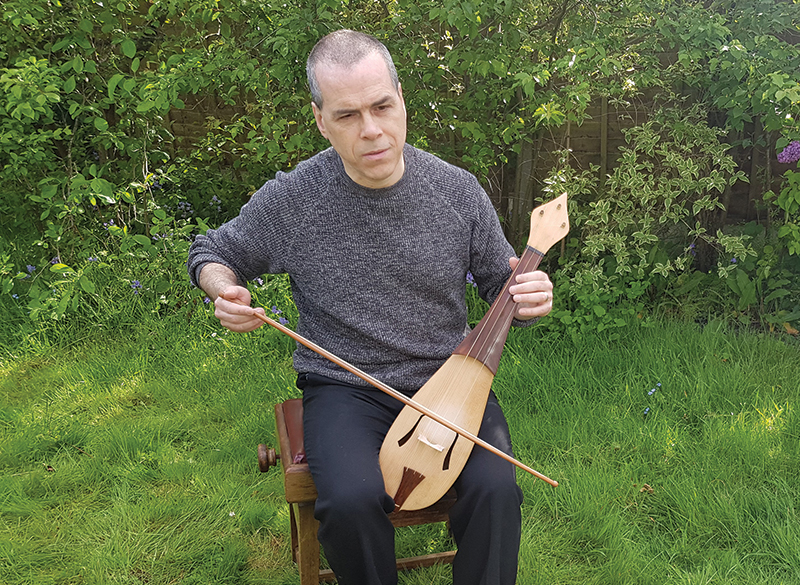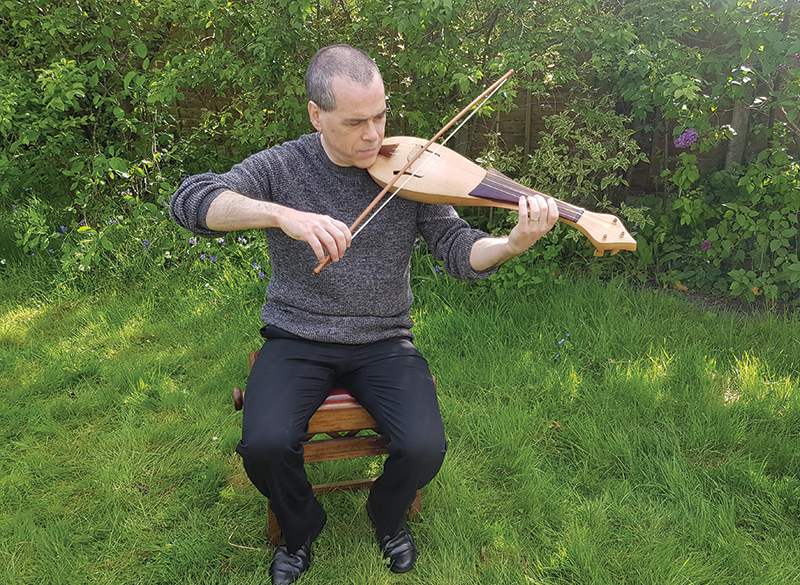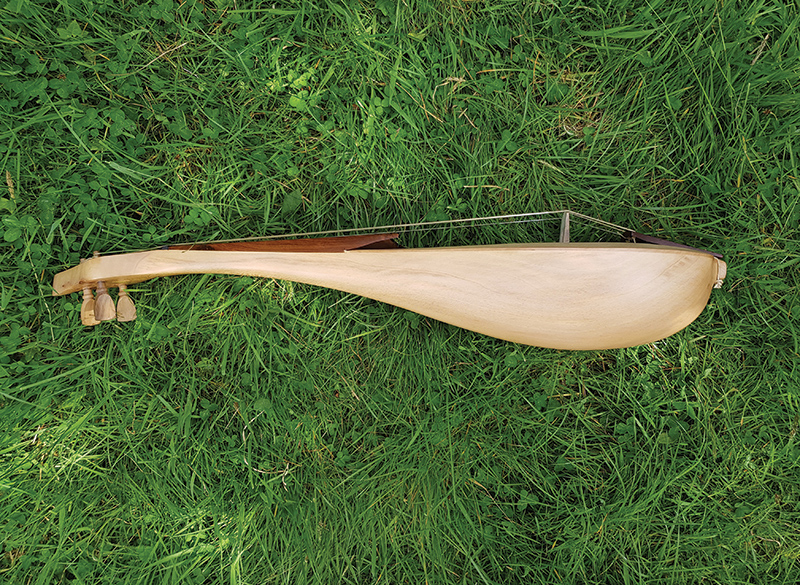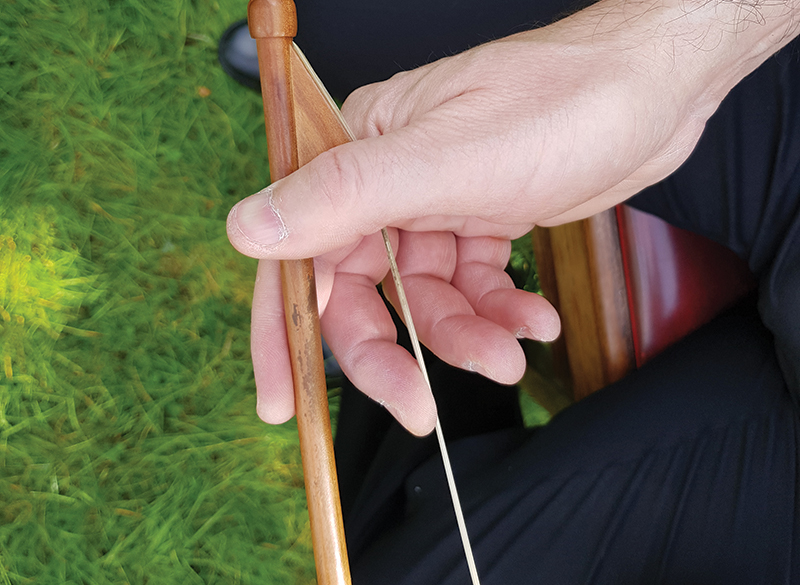Colin Huehns | May 2021 | London
In the previous issue of Vantage, ‘Dolce Melos’, the first essay on Dr Colin Huehns’s collection of stringed instruments, was published. Here, the second essay, entitled ‘A Smal Rubible’, on the medieval rebec, follows.
A Smal Rubible
The Medieval Rebec
The earliest depictions and archaeological evidence of bowed instruments emerged in the tenth century in Central Asia. Within a hundred years or so, the innovative technology of applying a hunting bow to instrument strings to set them vibrating had spread east to China and west to Europe via the Arab world. By the eleventh century, representations of bowed instruments are commonly found in the European visual arts, particularly in Spain, which was partially ruled by Moorish conquerors. The Arab word for stringed instrument is rabab, which corrupted itself in European languages to become ‘rebec’ (or something similar) and, until the advent of the violin in the early sixteenth century, instruments of this type were an important genre. Figure 1 shows a modern reconstructed rebec next to its illustrious descendant, the violin.
The typical Central Asian or Arab bowed instrument tends to combine a spherical resonating chamber with an upright spike and is played balanced on the left thigh, as shown in Figure 2, where the version is a Uighur ghijek. Early Spanish sculptures of bowed instruments usually retain the vertical posture of their Arab prototype and a similar manner of performance to that of the rebec in Figure 3. Perhaps to increase sound projection by bowing with gravity assisting contact with the string, European bowed instruments were, before long, wedged under the chin or balanced on the shoulder and held horizontally or pointing downwards (Fig. 4). This posture is difficult to sustain for this particular rebec as it is too heavy.
Many depictions of the rebec survive, and their hallmark is a characteristic tear shape with a smooth, round back (Fig. 5). As a cheap and cheerful vernacular instrument, none were preserved for posterity, and no actual specimens remain. Three strings are most common, though some pictures portray four. The pegs point backwards, and the neck is one continuous curve from the pegbox to the contours of the soundbox. Soundholes are rudimentary and the front is unvarnished. This rebec is furnished with a soundpost inside the instrument, as indeed is the Uighur ghijek, but there is no evidence that this fitting was present on medieval examples of either. The rebec bow is a simple arched curve and equipped with horsehair, though the ghijek bow has taken influence from the violin and its stick is parallel to the hair.
Evidently a popular instrument, the rebec is mentioned twice in Chaucer’s Canterbury Tales. In ‘The Miller’s Tale’, the rather effeminate Absolon plays it:
And pleyen songes on a smal rubible;
Therto he song som tyme a loud quynyble;
Rendered into modern English this reads:
And played songs on a small rebec,
With which he sang at times in a loud high treble voice.
In ‘The Cook’s Tale’, the scurrilous apprentice is the performer:
For thefte and riot, they been convertible,
Al konne he pleye on gyterne or ribible.
Rendered into modern English this reads:
For thieving and riot are interchangeable,
Even though he knows how to play on a cithern and rebec.
Although the violin first appeared in the early sixteenth century and was self-evidently a vastly superior sound-producing apparatus, the first independent composition that specifically includes it and that contains idiomatic writing did not appear until Monteverdi’s Orfeo of 1607, and thus the rebec and violin clearly coexisted for many decades. In the early seventeenth century, Spanish writer Cervantes mentions the rebec several times in his satirical novel Don Quixote, and to this day there exists in Taipa, Macau, a street called in Chinese 빚핵쌍 (Huqin [Erhu] Street), which in Portuguese is rendered ‘Travessa da Rebeca’ and whose street sign is clearly labelled in both languages. As the baroque forms of opera, sonata, and concerto prospered, the rebec no longer had a role and met its demise in the mid-seventeenth century.






There is a quiet elegance to the smooth curves of the rebec that is particularly alluring when compared with the sharp points of violin contours. So too are its depictions in the visual arts, but its voice has been stilled and there is no surviving music for it. Such instrumental music as has survived from the medieval period is mostly for organ and extremely rudimentary, although it is reasonable to assume that polyphonic parts in vocal compositions were doubled instrumentally or even performed entirely without voices. Strung with gut strings, the rebec’s sound is quiet and intimate, and ill-suited to public performance at all. Both Chaucer’s and Cervantes’s accounts suggest playing for personal satisfaction rather than external appreciation.
On playing the instrument itself, this is the kernel of the experience, a sensation both dreamy and profound. Perhaps one sits on the battlemented turrets of a crusader castle in Outremer and the sun is setting into the horizon, the evening heat dispersed, and the night cool inviting. It is a prayerful time for stroking a bow across the strings, maybe accompanied by a hummed melody, a moment for the chivalric knight to reflect on his mission or ponder his lady.
The pitches to which the strings were tuned are not known either and were probably different from one rebec to another. On experimentation, the most successful combination is for the outer two strings to be an octave apart and the middle string a fourth or fifth between them. This gives ample opportunity for using one or even two strings as drones against which a melody floats on the third string. The fingers seek naturally for sonorities, and at first pentatonic tunes seemed best. My own experience of the instrument started simply with improvisation of modal melodies following my dreams.
Surprisingly perhaps, given such a rudimentary bow, the whole gamut of violin technical devices is still available. It is extremely light, and thus held with just the index finger curled around the stick and the middle finger pressing the hair (Fig. 6). Similar bow grips are also found on the erhu, viol, Mongolian fiddles, and double bass, but, of these, only the viol also uses only these fingers, and the others use more. A particularly telling technique is ricochet, by which the bow is thrown and bounces several times. Spiccato and tremolo are also highly effective, but the aesthetic the instrument demands is legato and tranquil, and when playing it somehow this is always where everything ends up.
Aside from self-indulgent improvisation, when it came to evolving a repertoire, the first and most inviting tip-off was a passage in Don Quixote as translated by Thomas Shelton shortly after it was written. In this scene, Don Quixote is in the mountains when ‘the sound of the Rebecke touched his eare, and within a while after he arrived that played on it, being a Youth of some twenty yeers old, and one of a very good grace and countenance… and without further intreaty, sitting downe on the truncke of a lopped Oke [oak], he tuned his Rebecke, and after a while began with a singular good grace to sing in this manner:’ (Quotations of Don Quixote taken from the first English edition of the early seventeenth century by Thomas Skelton with original spellings retained.)
There then follow the words to the song, sung to the accompaniment of the rebec. This was irresistible! Although the poem is long, I set the whole of it to music, singing while playing and using only pentatonic patterns – three of these are available using the open strings plus additional stopped notes – while also deploying every single technical trick in my string-playing armoury to bring out the emotion of the words. A lovesick youth, he sings:
‘I know, Olalia! thou dost me adore,
Though yet to me the same thou hast not said.’
But, like Don Quixote himself, his whole persona is one of self-deceit:
‘When thou didst at Cockcrow listen alone,
And seemd’st hearing my voice, to be in heaven.’
She, of course, is not interested in the slightest and simply offers him:
‘rigor’s Winter face.’
But nonetheless, we feel sympathy for him when unquenchably he sings:
‘Sometimes hope peeping out, does promise grace.’
Thankfully, hope does spring eternal, and we are refreshed by his passion in the same way that we are glad of Don Quixote’s inadequacy.
A substantial composition under my belt, and one – in ethos, if not actual notes – an authentic replication of a rebec performance scenario, more followed. Ockeghem is a sadly neglected composer of the late medieval and early Renaissance whose oeuvre includes all the principal genres of contemporary music, such as sacred polyphony and secular chansons. His mass settings, unlike those of most other composers of the time, often include substantial sections in two-counterpoint, interpolated amid sections of multipart polyphony. This, again, was an opportunity to sing and play at the same time, either singing the top part and playing the bottom part or vice versa.
There are problems, however, to either arrangement. Singing and playing at the same time is not easy. It is possible on the guitar if the accompaniment is simple and chordal and because notes are sounded by the sudden movements of plucking, but much more difficult on a bowed instrument as the bow must be kept at an even speed and pressure when being drawn across the string, otherwise there will be blemishes in the sound. The intonation of both singing and playing must match perfectly, else the effect is unintelligible, and, whereas the guitarist is helped by frets, the rebec has none. For the Don Quixote composition, my solution was simply to alternate moments of high activity between the voice and instrument, so that only rarely were both in counterpoint with one another. Playing and singing the Ockeghem presented another problem entirely.
The secret, of course, is through practice to render the difficult easy, but, as well as the absence of original rebec repertoire, there are also no scale books, studies, or guides to technical progress and achievement. The learner simply does not know what is possible because no one has trodden the path before, at least not for five hundred years. What an exciting challenge! Taking inspiration from Chaucer, I have written one substantial solo rebec composition and invite others to do more. Why not? ′
Essay 1 was featured in the previous issue of Vantage and Essay 3 will be featured in the upcoming issue of Vantage.
About the Author: Dr Colin Huehns studied violin with Emanuel Hurwitz. His first experience in music from outside the Western Classical tradition came at King’s College, Cambridge, when he wrote a dissertation on the music of Hunza Valley and Gilgit, Pakistan, an interest which culminated in a PhD thesis awarded by Cambridge University for ‘Music in Northern Pakistan’ in 1992.
He studied composition at the Royal Academy of Music and has remained active as a composer. Following a three-year British Academy Research Fellowship at Cambridge, Colin spent three years as a student at the Xi’an Music Conservatoire, studying the erhu with the distinguished virtuoso Jin Wei.
Since returning to the UK in 1999, he has taught electives in non-Western, traditional, and folk music at the Academy. He has also taught electives, which include learning the erhu, and Chinese and British members of the dulcimer family. As well as continuing to play the viol, viola, violin, rebec, Renaissance fiddle, and various dulcimers, his main teaching, research, performance, and composition interests now centre on his Chinese instruments, which include some twenty different members of the erhu, yangqin, and Mongolian horsehead fiddle families.
Colin’s erhu performances have included recitals in Munich, Leeds, Cambridge, and Edinburgh, but he is particularly proud of having recorded two CDs of erhu music written especially for him.

